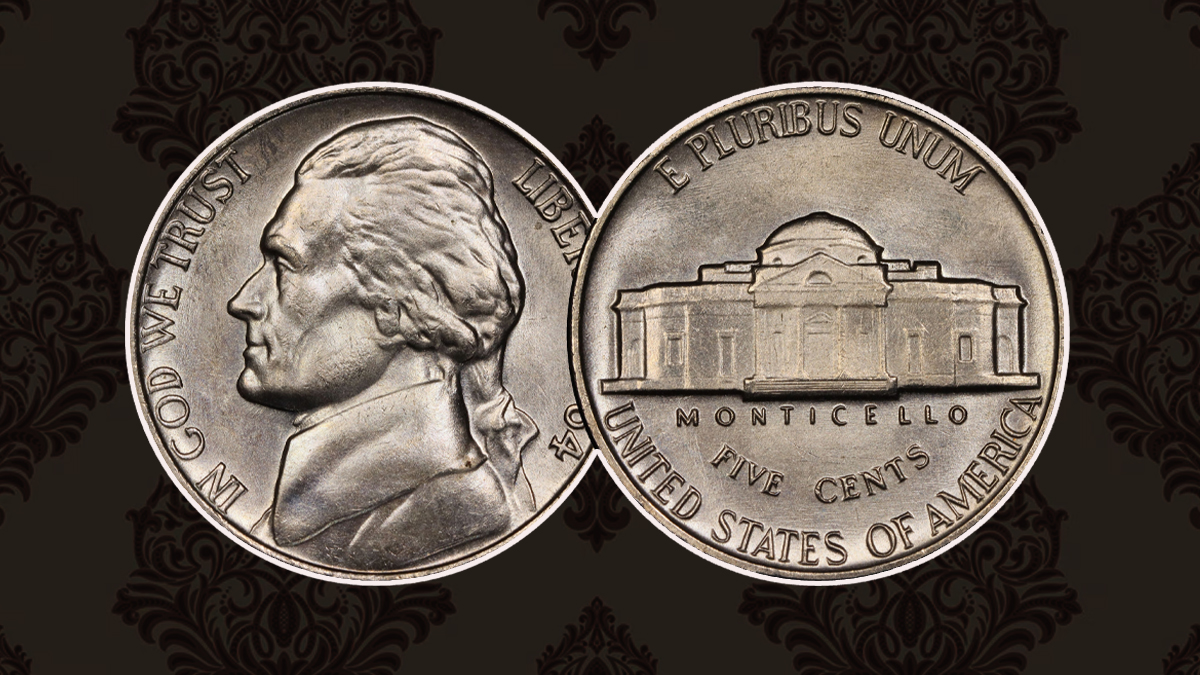
The 1964 Jefferson Nickel has the highest mintage for any nickel ever struck by the U.S. Mint. It was also the first year in which the mint struck over a billion nickels for any date. Compare this to the 1950-D Jefferson Nickel, which has a mintage of 2,630,000. The 1964-D Jefferson Nickel has a high mintage, but it’s also one of the toughest dates in the series to find in excellent condition.
PCGS has only graded about 35 examples in MS66 with none higher. With Full Steps, it is considered even scarcer, with about 5 known examples in MS66 Full Steps with none finer. A few excellent examples in MS66 grade or larger with Full Steps are hidden within this huge mintage of 1964-D Jefferson Nickels.
The 1964 Jefferson Nickel has the highest mintage of about three billion coins, making it the most minted nickel in United States history. Among the Most Valuable Nickels, it holds a unique place due to its high production numbers. Nickels dated 1964 were produced well into 1966, marking the only mintage year that carried over through multiple years in the coin’s history.
The 1964 Jefferson Nickel was the first nickel to surpass one billion coins minted, with the large mintage numbers attributed to a coin shortage caused by the hoarding of silver in the early-to-mid 1960s.
During coin shortages, mintmarks were suspended from 1965 to 1967 to discourage currency hoarders from storing mintmarked coins. The shortage’s more noticeable negative impacts ended in late 1966 or early 1967, and mintmarks came to increase in 1968.
History Of 1964 Jefferson Nickel
In 1938, the Buffalo Nickel was made for the Jefferson Nickel as the official five-cent piece of the United States. The Buffalo Nickel was one of the most troublesome coins to strike in United States history, leading to a quick decision to replace it after its mandatory 25-year term ended. The United States Mint held a competition for the new coin’s design at the start of 1938.
The Mint’s requirements for the new coin were that former President Thomas Jefferson be featured on the obverse and his house, Monticello, be featured on the reverse. Artist Felix Schlag won the competition but was required to submit a completely new design for the reverse and make other aesthetic alterations before production began in October 1938.
The Jefferson Nickel debuted in 1938 after Felix Schlag’s design won the nationwide contest, honoring the third U.S. president, Thomas Jefferson. With this, a new five-cent piece that is still in use today was generated. Nickel was a valuable metal that was essential for the war effort during World War II. Nickels issued from 1942 to 1945 were minted using a mixture of copper, silver, and manganese. There are over 150 recognized varieties today, including the 2004-2005 designs and strikes.
Specification:
- Mints: Philadelphia, Denver
- Total Produced:
- Overall: 2,815,919,922
- Philadelphia: 1,028,622,762
- Denver: 1,787,297,160
- Weight: 5.00 grams
- Diameter: 21.21mm
- Edge Type: Plain
- Composition: 0.750 copper, 0.250 nickel
- Designer: Felix Schlag
- METAL: 75% Copper, 25% Nickel
Design
Obverse:
Designer Felix Schlag’s side profile of Thomas Jefferson centers the obverse of the coin, taking up about 80% of the space. His bust resembles one created by sculptor Jean-Antoine Houdon, found in Boston’s Museum of Fine Arts.The depth of the profile is striking in near-mint versions, visually popping off the coin and giving it unique gravitas.
The phrase “In God We Trust” wraps the left edge of the coin to the left of Jefferson’s bust. The word “Liberty” and the mintage year wrap the right edge of the coin, separated by a miniature star that can be mistaken for a dot at first glance.
Reverse:
Felix Schlag’s original design for the reverse featured a three-quarters view of Jefferson’s estate, Monticello. The United States Mint removed a tree from the design and modernistic lettering Schlag used. Schlag’s redesign is much stronger than the original.
A plain, straight-ahead rendering of Monticello stretches horizontally across the center of the coin, with the word “Monticello” directly underneath. Above the Monticello rendering is the phrase “E Pluribus Unum,” arching across the top edge of the coin. Below “Monticello” are the phrases “Five Cents” and “United States of America,” in arches that mirror the phrase on top of the reverse.
Errors and Variations
Jefferson nickels minted in the late 1950s through the mid-1960s often suffered from poor strikes, resulting in weakened and soft details compared to earlier years. The 1964 Jefferson nickels frequently appear distorted, except for the rare uncirculated versions and the 3.9 million proofs created for collectors.
Despite their high mintage numbers, uncirculated and proof versions of the 1964 Jefferson nickel are much rarer and more valuable to collectors. Numerous 1964 Jefferson nickel errors exist on the secondary market. Notable errors include double- or triple-struck versions with the “D” mintmark for the Denver Mint. Variations also include coins that appear thinner or incompletely struck due to poor die quality.
Grading and Condition
- The condition of Jefferson’s bust on the obverse is essential when evaluating the value of a 1964 Jefferson nickel.
- Wear usually begins on Jefferson’s cheekbone, moving towards his hair and the bottom of the bust as the coin circulates.
- An About Uncirculated (AU-50) version will show only minor wear.
- Anything more, and the coin is likely at face value in Extremely Fine grade or below.
- Coins at the lower end of the grading spectrum (Very Good to About Good) will show significant wear on Monticello’s roof and structure on the reverse, with phrases potentially merging into the edge.
- For a 1964 Jefferson nickel to have any value above face, it must have only slight blemishes, trace nicks, or scratches, and retain nearly all of its mint luster.
- Due to poor striking, finding such coins is rare.
- This grading difficulty means 1964 Jefferson nickels are rarely collected by serious collectors unless they are in Choice Uncirculated (MS-65) condition or higher.
Value Of 1964 Jefferson Nickel
The value of a 1964 Jefferson nickel is typically face value unless you find an uncirculated, barely-handled piece.
These high-quality nickels are hard to find, especially in grades of MS-65 or above.
Near-mint and proof 1964 Jefferson nickels see a sharp increase in value.
Anything below this threshold holds negligible monetary value above face value.
Good (G-4) to Extremely Fine (VF-20): Face value
Uncirculated (MS-60): $0.26
Choice Uncirculated (MS-65): $8.47
Proof (PR-65): $3.06
Also Read – 1913 Liberty Head V Nickel: A Collector’s Guide
Conclusion:
The 1964 Jefferson Nickel is a fascinating coin with a rich history and notable distinctions. Despite its record-breaking mintage of nearly three billion coins, finding high-grade examples, especially those with Full Steps details, remains a challenge. Poor strikes and weak details from the mid-1960s contribute to the scarcity of high-quality specimens.
Collectors value uncirculated and proof versions, with coins in Choice Uncirculated (MS-65) condition or higher being particularly prized. While the vast majority of 1964 Jefferson Nickels are worth only face value, those few in excellent condition can command significantly higher prices. This combination of high mintage and grading difficulty makes the 1964 Jefferson Nickel a unique and interesting coin for collectors.
